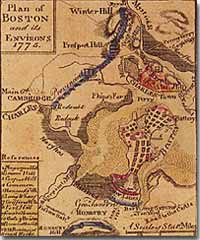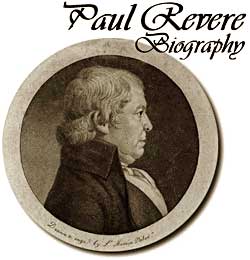
The Declaration of Independence
Lesson Plan
The Boston Patriots
- Why was the town of Boston at the forefront of rebellion?
- Who were the leading voices in Boston opposing British Authority, what were their occupations and what were they known for prior to the Declaration of Independence?
- Who were the Sons of Liberty and what did they do?

Boston was the home for many patriots and supports of the American cause. This map shows the plan of Boston in 1775, at the height of the Revolution.
The American Revolution was not only a series of events. There were many men and women whose actions and difficult decisions led to the great war.
Although patriots could be found in any of the 13 colonies, they were most common in Boston. There are many reasons why. First, Boston was highly affected by the restrictions on trade due to the large presence of shipping. The city also had a long history of conflict with the Church of England. Finally, town meetings and self-rule were established in Boston over 150 years before, and helped to lead other New Englanders to question British authority.
These and other factors led the city of Boston to be the leading voice against British authority. After all, it was the location of the Boston Massacre and the Boston Tea Party. Fierce patriots such as James Otis, Samuel Adams, John Adams, John Hancock, and Paul Revere were all citizens of one great city: Boston.
James Otis
James Otis was one of the first strong opponents of British taxation policies. He was an attorney, and Boston merchants often hired him to defend them against British search warrants. He wrote an essay called The Rights of the British Colonists Asserted and Proved that was one of the first legal criticisms of Parliament's tax policies. It was very widely read in Massachusetts and the other colonies. The British saw Otis as treasonous, but in the colonies he was viewed as a large man with a large heart for British liberties.
Otis was a believer in rights for the colonies. However, he also felt loyal to England. Once, he stormed into Boston's Royal Coffee House because British soldiers there were questioning his loyalty to England. Those accusing him drew their swords and a violent fight broke out. Otis was beaten so badly that he never really recovered. The wounds he received made him a hero in Boston.
Find a link for James Otis, review it and rate it for trustworthiness
You are making a movie about the life of James Otis. What are you going to call it? Think of an appropriate title that will get people to see your movie!
Samuel Adams

Samuel Adams was one of the fiercest supporters of American liberty in the 13 colonies. He wanted to protect the colonies from the evils of the British Empire and move toward a more simple American life. Adams was a very skilled political organizer, which helped the colonies. He even chaired the Boston town meeting that first brought up the idea of the Boston Tea Party.
Adams was not successful in many of his jobs and duties before the Revolution. He seemed to find his calling in political organizing, though. He served as an active member of a group called the Sons of Liberty and created the first real committee of correspondence. The more involved he became in the call for independence, the more the British wanted to get rid of him.
John Adams
John Adams was Samuel's second cousin, and was also a well-known patriot. He was a defense attorney for the British soldiers in the Boston Massacre, but most of his efforts were focused toward American independence.
John Adams was skilled with words. He wrote the message sent to George III that was adopted by the First Continental Congress. John and Samuel Adams were part of the radical wing of the Second Continental Congress that demanded that the colonies use weapons against Britain. John Adams was also one of the four men who assisted Thomas Jefferson in drafting the Declaration of Independence.
John Hancock
The man with the famous signature — John Hancock — was also a Bostonian. British officials disliked Hancock because he was a major smuggler. The seizure of one of his ships led directly to British occupation of Massachusetts in 1768.
Later, Hancock and Samuel Adams were the two people General Gage ordered to be arrested after the battles at Lexington and Concord. Hancock was very wealthy, and had a lot to lose, but that did not stop him from actively resisting the British.
Paul Revere

Paul Revere did not come from the same social class as the other patriots mentioned here. As a silversmith, he was a man of humble means, but his attitudes about Britain were strong. His famous midnight ride warned colonists of the British troops moving in to Boston. That was only one of his revolutionary actions, however. He was also an illustrator, and his drawing of the Boston Massacre became famous.
Revere was active in politics when the British suspended the Massachusetts legislature for its "circular letter." He engraved a silver bowl with the names of the 92 men who stood up to Parliament to support the letter. Ever since, it has been called the "Liberty Bowl." Patriots used many of his engravings as anti-British propaganda, particularly his famous engraving of the Boston Massacre.
These five men, and many other Bostonians, became known for their actions to protect the colonies. Their bravery inspired others throughout the 13 colonies. As the American Revolution was getting close, the Boston patriots led the way.
Pick one of these Patriots and describe something you admire about him.
- Why was the town of Boston at the forefront of rebellion?
Start page | The Document | A Reading | Signers | Related Information | Jefferson's Account | Declaration House | Declaration Timeline | Rev. War Timeline | More Resources | Lesson Plan |




